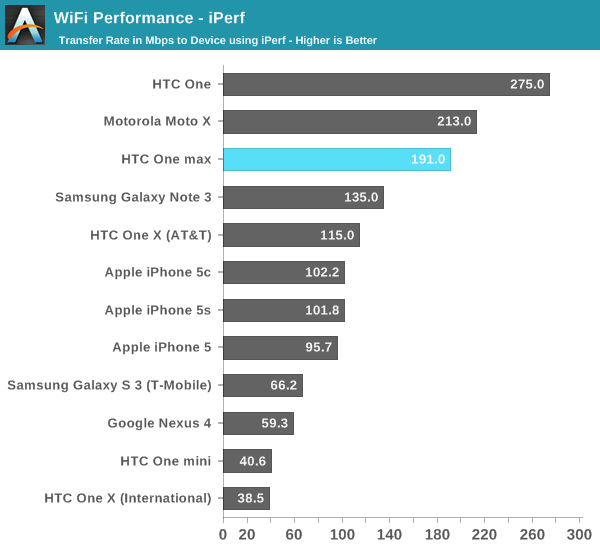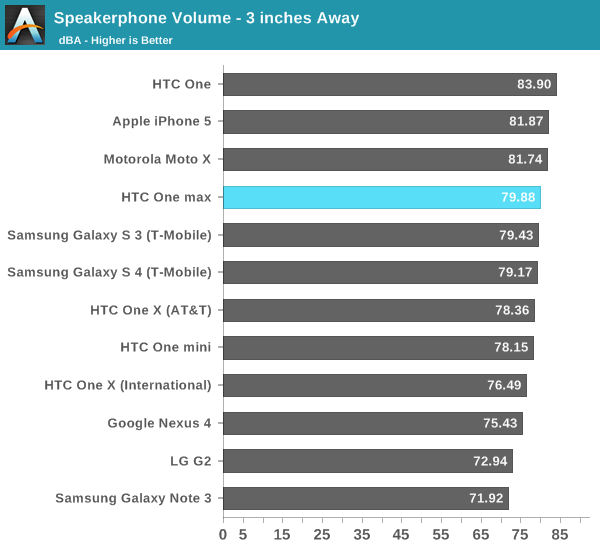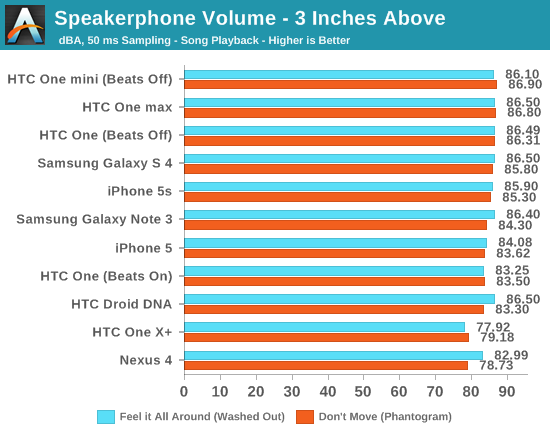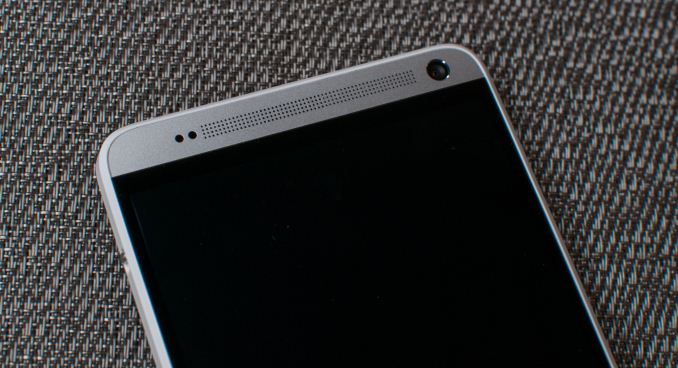HTC One max Review - It's Huge
by Brian Klug on October 28, 2013 10:00 AM EST- Posted in
- Smartphones
- HTC
- Mobile
- One
- Snapdragon 600
- Android 4.3
- One max
Cellular
Cellular on the One max is pretty much the same story as the One, and another shared bullet point. The top and bottom metal cutouts are still the radiative surfaces of the antenna, and there’s still transmit and receive diversity as well to mitigate any unwarranted antenna detuning from holding the device. The unit I was sampled has LTE banding for EMEA (Europe, Middle East, and Africa), but there’s appropriate banding for Asia, Sprint (a tri-mode device with 800/1900 MHz and TDD-LTE on 2600 MHz) and Verizon (700 MHz and AWS), according to the HTC specs page.
The baseband inside the One max is again shared with the One (Qualcomm’s 2nd generation multimode LTE MDM9x15 family), although the One max does have a bit more band support for the USA LTE on Sprint and Verizon, so the front ends are different.
WiFi
Interestingly enough with the One max we see HTC going to Qualcomm Atheros for the WLAN and BT combo, best I can tell this is the WCN3680 which is probably a bit cheaper to include than the BCM4335 we saw in the One. It’s still a single spatial stream 802.11ac capable part, meaning a PHY rate of up to 433 Mbps if you’re in the right channel conditions with 80 MHz channels on 5 GHz. The WCN3680 combo is the 802.11ac successor to WCN3660 which we saw in a number of phones last generation, and is accelerated by the SoC. WCN3680 also does BT 4.0, and FM Rx/Tx if applicable.

To test throughput on the One max I used iPerf the same way I have for a while now. Subjectively there are no complaints from me about WLAN connectivity on the One max, no random dropouts or issues, and Sense 5.5 thankfully still includes the WiFi frequency band manual selection option.
I saw the WCN3680 solution inside Moto X already, it’s interesting to see it in the One max. I believe the One mini uses its 802.11n cousin, WCN3660 as well, probably again for cost reasons.
Speakerphone
Although Beats is gone since that partnership has ended as of the One max, the device still seems to retain everything that made it sound great. There are still the larger-than-typical speaker chambers, big speaker grilles on the top and bottom, stereo sound, and importantly the TFA9887 speaker amplifier and protection part from NXP. In addition there’s still the TPA6185 headphone amplifier as well.
Beats always seemed to be an audio compressor that ran on the DSP, ostensibly through the Hexagon DSP access program or something, and that’s what’s absent on the One max. There’s no toggle under settings for enabling or disabling it, nor the Beats branding, but to be honest I almost always disabled Beats on the One anyways since it was a fair amount louder with it disabled. What made the One great was all the hardware behind the speakers, not so much the software compressor.


The One max goes plenty loud just like the original One. I went ahead and added the One mini and 5s to the chart too, just to check whether things have changed much, in addition to the Galaxy S 4 and Note 3. The One max basically performs like the One with Beats turned off, which isn’t a surprise since it isn’t there anymore. There’s also no detectable saturation, and the One line remains the only device that doesn’t sound tinny or rattly with overemphasized highs and lacking mids. I suspect the A weighting I selected a while ago for measuring might be a contributing factor as well. Either way you’re not going to be wanting for more loudness on the One max, and the inclusion of front firing stereo speakers makes for a completely different listening experience.












197 Comments
View All Comments
Steven JW FCK - Monday, October 28, 2013 - link
How can you say a "very tiny part of the market" and know for certain? I know so many Samsung smartphone users, and do you want to know how many of them have been asked by Samsung how they use there micro SD cards, and the data storage facilities on their phones?NONE OF THEM!
So where on earth are you pretending to get your data from? And how exactly are you interpreting the numbers? I just fail to believe you actually know the ins and outs of phone storage and micro SD card usage in smartphones upon a broad enough scale to start making allegations like you have.
Believe the reality you want, it only exists in a very small and exceptionally annoying minority.
rabidkevin - Tuesday, October 29, 2013 - link
Bullshitsuperflex - Tuesday, October 29, 2013 - link
Agreed.Someone need to grease their gears. Their screech is annoying and not supported by a vast majority.
lazymangaka - Monday, October 28, 2013 - link
I don't understand the the reviewer's hatred of MicroSD cards. They're a useful thing to have, for every type of user. And, the fact of the matter is, internal storage space has not been rapidly increasing in smartphones. Storage needs have, however. Unlimited data plans are gone for many users, so listening to locally-stored music makes much more sense. In addition to that, the megapixel count of smartphone cameras continue to march north, and those larger file sizes are competing with ever-increasing app sizes. MicroSD expansion just makes sense.I understand what Google was trying to do in nixing external expansion in its Nexus lineup, but it just hasn't played out the way they wanted it to. Instead of getting a phone with 16GB of internal storage and an external expansion slot, we're more likely to just get a phone with 16GB of internal storage. Campaigning for the continued removal of MicroSD storage is doing nothing but harming us all.
Mondozai - Monday, October 28, 2013 - link
Lazumangaka:"I don't understand the the reviewer's hatred of MicroSD cards."
Every reviewer have their irrational foibles that makes no sense. You just have to learn those blindspots and avoid them like the plague with each particular reviewer.
With Brian we know he hates WP8, he dislikes microSD cards and he winces on AMOLED screens. He still puts out very qualified reviews but again, know when to listen, and when to just skip.
Brian Klug - Monday, October 28, 2013 - link
Luckily it's easy to back up the dislikes of microSD (poor Android support, slower than native storage, tradeoffs in build quality) and AMOLED screens (oversaturated, higher power drain, burn in, and sensitive to overheating), and reasons why I can't get anything done on WP8. They aren't blind spots that make no sense, they're just realities.-Brian
PC Perv - Tuesday, October 29, 2013 - link
What an arrogant hoax. You surely realize that every point you raise has counter points, right?How about being on consumer side for once? Make a case why 32 GB should be the bottom line. And why 64 GB should cost $20 more, not $100 more, etc,. Stop worrying about OEMs. They are doing fine. Think for once from consumers standpoint, instead of corporate-hired marketeering.
rabidkevin - Tuesday, October 29, 2013 - link
Hello apple paid spokepersonsuperflex - Tuesday, October 29, 2013 - link
Hello Samsung ShillDentons - Tuesday, October 29, 2013 - link
You're displaying confirmation bias, writ large.We can all find window dressing to support our opinions. That's why so many here object to your rants on AMOLED, microSD, and batteries. Despite your technical expertise, we realize your opinions in those areas has little basis in truth, and is largely just an smug opinion.
Yes, the NAND on many microSD cards is inferior to NAND built into devices. We know and we Don't Care! We use it to hold mass media, videos, photos, and music. What we care about far more is that microSD is often 10 times more cost effective and functions very well indeed.
Really Brian, telling users they really don't need the features they use and love is the height of contemptuous arrogance.